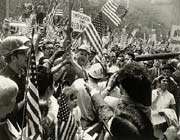The Day in History
Hard Hat Riot
The Hard Hat Riot was a riot which occurred on May 8, 1970, near the intersection of Wall Street and Broad Street and at New York City Hall. The riot occurred about noon when about 200 construction workers mobilized by the New York State AFL-CIO attacked about 1,000 high school and college students and others protesting the Kent State shootings, the American invasion of Cambodia and the Vietnam War. The riot lasted little more than two hours, and ended of its own accord. More than 70 people were injured, including four policemen. Six people were arrested.
Background
On May 4, 1970, four students were shot and killed at Kent State University in Ohio while protesting the Vietnam War and the incursion into Cambodia. As a show of sympathy for the dead students, Republican Mayor John Lindsay ordered all flags at City Hall to be flown at half-mast the same day.
The American labor movement was deeply divided over support for President Richard Nixon's Vietnam policies. AFL-CIO President George Meany and most labor leaders in the United States were vehemently anti-communist and strongly supported American military involvement in Southeast Asia. But by 1970, union members were nearly split in their support for the war. One of the strongest supporters of the president's war policy was Peter J. Brennan. Brennan was president of the Building and Construction Trades Council of Greater New York, an alliance of building and construction unions in the New York City area. The building and construction unions were overwhelmingly blue-collar and male, and large majorities of these union members supported Nixon's Vietnam policy.
Shortly after the Kent State shootings, student anti-war protesters announced they would hold a rally near City Hall to memorialize the four dead students. Brennan quickly decided to organize a counter-rally of construction workers to show support for the Nixon administration.
The riot
At 7:30 a.m. on May 8, several hundred anti-war protesters (most of them high school and college students) began holding a memorial at Broad and Wall Streets for the four dead students at Kent State. By late morning, the protesters—now numbering more than a thousand—had moved to the steps of Federal Hall, gathering in front of the statue of George Washington which tops the steps. The protesters demanded an end to the war in Vietnam and Cambodia, the release of "political prisoners" in the United States, and an end to military-related research on all university campuses.
At five minutes to noon, about 200 construction workers converged on the student rally at Federal Hall from four directions. Nearly all the construction workers carried American flags. Their numbers may have been doubled by a number of other counter-protesters who had joined them as they marched toward Federal Hall. A thin line of police formed to separate the construction workers from the anti-war protesters. At first, the construction workers only pushed but did not break through the police line. After two minutes, however, the workers broke through the police line and began chasing students through the streets. The workers pursued those with the longest hair and beat several severely. Attorneys, bankers and investment analysts from nearby Wall Street investment firms tried to protect many of the students but were themselves attacked. Onlookers reported that the police stood by and did nothing.

Some of the construction workers and counter-protesters moved across City Hall Park toward New York City Hall. They mounted the steps, planted their flags at the top of the steps, then attempted to gain entrance to City Hall. Police on duty at City Hall initially barred them, but soon the mob pushed past these guards. A few workers entered the building. A postal worker rushed onto the roof of City Hall and raised the American flag there to full mast. When city workers lowered the flag back down to half-mast, a large number of construction workers stormed past the police. Deputy Mayor Richard Aurelio, fearing the building would be overrun by the mob, ordered city workers to raise the flag back to full mast.
Rioting construction workers also attacked buildings near City Hall. They ripped the Red Cross and Episcopal Church flags down from a flag pole at nearby Trinity Church. Then they stormed two buildings at nearby Pace University, breaking windows and beating students with clubs and crowbars.
More than 70 people were injured, including four policemen. None of the injuries were severe, although most of the injured required hospital treatment. Only six people were arrested.
Aftermath
Mayor Lindsay took the blame for the lack of action by the police.
President Nixon held an emergency press conference to defuse the situation before tens of thousands of students arrived in Washington, D.C., for a protest rally on May 9.
The Hard Hat Riots were followed by a series of peaceful, police-guarded pro-war rallies in New York almost every day during May. These rallies, led by Noah Abelson, culminated in a large rally on May 20. Over 100,000 construction and other workers peacefully marched through the streets of downtown New York City. Workers in the surrounding buildings showed their support by showering the marchers with ticker tape. There is some debate as to how spontaneous these pro-war rallies were, as most laborers could not afford to miss work for weeks on end.
Source: encyclopedia.freedictionary.com